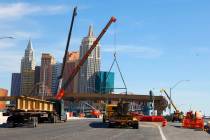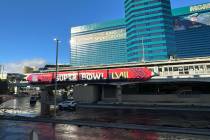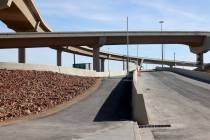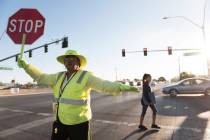Flashing lights must be lawful
This week readers want to know if a motorist has to pull to the right for a private security vehicle and what are the height limits on vehicles?
Don asks: Do I have to pull to the right for a private security vehicle if the driver has flashing lights? Can they exceed the speed limit?
The reader explained to me that this question evolved from an incident that happened on U.S. Highway 95. The private security vehicle with its flashers on began tailgating the reader. He said that in the rear view mirror the vehicle looked like it could be an unmarked law enforcement cruiser, so he pulled to the right.
That’s when he saw that it was actually a private security vehicle as it sped off.
I checked with Nevada Highway Patrol Trooper Kevin Honea — even though the answer seemed painfully obvious — and he said a private security vehicle would have no jurisdiction to act in such a manner on U.S. 95.
During some research, I also discovered under Nevada Revised Statute 484.493 a police officer could “remove and destroy, or cause to be removed and destroyed, all red, blue or amber lights and all sirens unlawfully installed or operated.”
Emergency vehicles, such as police cruisers, fire trucks or ambulances (including private companies so authorized by a government agency) can use red and blue lights.
And those are the lights that all other motorists need to worry about and move to the right for.
Other vehicles are allowed to use flashing amber lights but they must obtain a permit from the Highway Patrol.
That law states vehicles that can use flashing amber lights on public roads are public utility vehicles, tow trucks, some construction vehicles, coroner vehicles, Civil Air Patrol rescue units, authorized sheriff’s jeep squadrons, vehicles that escort funeral processions and food or beverage vendors.
However, Honea said a private security vehicle could operate under different rules once on private property or under the guidelines of a homeowners association.
Spencer Hawkins asks: Is there a law for off-the-ground height limits for vehicles? Does Nevada have laws against tires outside the wheel wells?
Yes, Nevada has laws that cover both of your questions.
Nevada Revised Statute 484.7385 covers how high a vehicle can be off the ground.
The law measures from the ground to the lowest portion of the vehicle’s body. In the case of passenger vehicles, it’s 24 inches.
The larger the vehicle the higher it can be off the ground. A 4,500-pound vehicle cannot be more than 28 inches off the ground.
A vehicle weighing 4,500 pounds but less than 7,501 pounds, cannot be more than 30 inches off the ground.
A vehicle that is more than 7,501 but less than 10,001 pounds, cannot be more than 32 inches off the ground (The law does not apply to vehicles that weigh more than 10,001 pounds or were made before 1935).
The second part of NRS 484.7385 states, “The measurement taken to determine compliance with this section must be taken from level ground to a portion of the body or parts attached to the body which have not been added or altered from the manufacturer’s original body design.”
Onto the second part of the question.
NRS 484.759, section 4, states a vehicles using pneumatic or air filled tires cannot have a maximum width — from the outside of one tire to the outside of the opposite tire — of more than 108 inches. The law also states, the body of the vehicle or the load must not be more than 102 inches.
If you have a question, tip or tirade, call Francis McCabe at (702) 387-2904, or send e-mail to roadwarrior@reviewjournal.com. Please include your phone number.
Motorists should expect lane restrictions on Lorenzi Street, between Alta and Westcliff drives, and on Jones Boulevard, between Evergreen Avenue and Borden Circle as the result of an $8.7 million flood control project that began Monday. Construction will also occur on Alta, between Easy Street and Decatur Boulevard, and on Evergreen, between Easy and Digger streets. The project will take about a year to finish. Lane restrictions and some road closures can also be expected.Two new traffic signals have begun operating on Grand Central Parkway at Carson Avenue and at City Parkway. Motorists should proceed with caution until becoming familiar with the signals. The traffic signal installations are part of the ACE rapid transit improvement project, which is scheduled to start in January.
The Nevada Department of Transportation announced the following updates to the Interstate 15 north widening project:
• D Street at Interstate 15 will be closed from 9 p.m. Thursday through 5 a.m. Monday for girder placement.
• Washington Avenue at Interstate 15 will be closed in each direction from 11:30 p.m. Thursday to 5 a.m. June 24 for girder placement.
LAS VEGAS REVIEW-JOURNAL


















